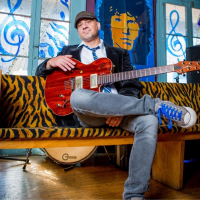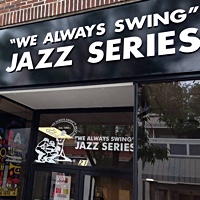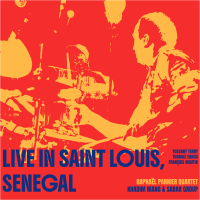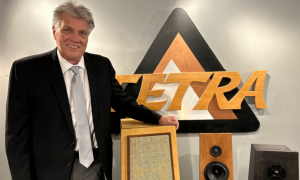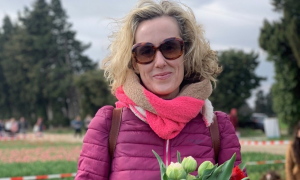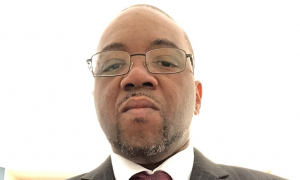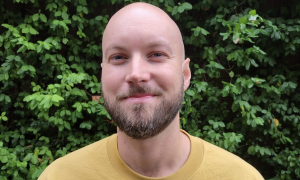Home » Jazz Articles » Chats with Cats » The Series Presenter: Jon W. Poses
The Series Presenter: Jon W. Poses
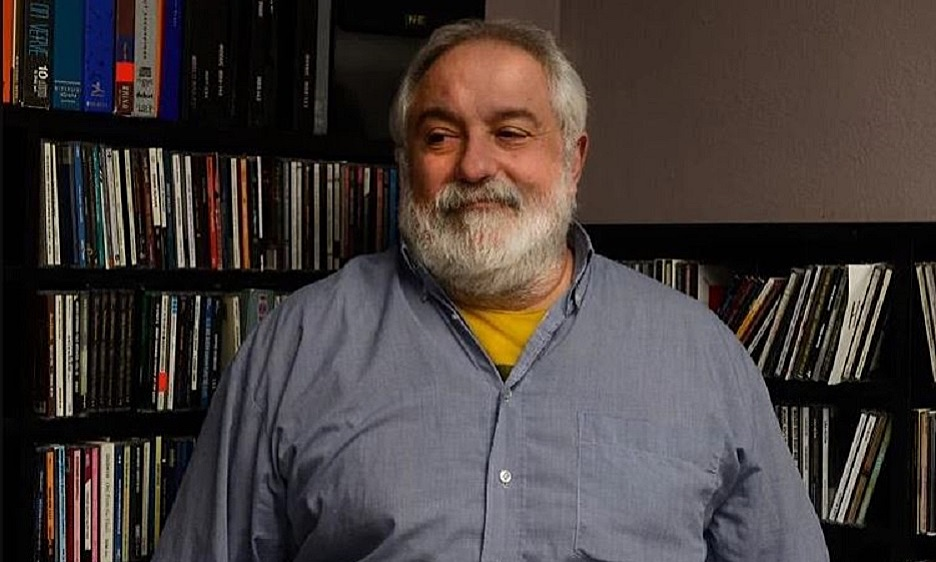
Courtesy Columbia Missourian
Having people come up to us and say after a concert, 'Now I get it,' meaning the music made sense to them; that's a way to define success.
—Jon Poses
About Jon Poses
A native of Queens, New York, Jon W. Poses attended the United Nations International School from second grade through eighth grade where his classmates and teachers were from all around the world.He later graduated from Emerson College with a B.S. in Mass Communications. Unsure of his next move, he left for Europe, traveling throughout the continent for the next eight months before returning to New York. Upon earning a master's degree in journalism from the University of Missouri School of Journalism (MU), Poses taught journalism at area colleges and served as a volunteer radio announcer and Jazz Director at community radio station KOPN-FM, in Columbia, Mo.
Simultaneously, Poses pursued, what would become, a successful freelance journalism career. Although he covered a number of subjects, he concentrated primarily on jazz and major league baseball—what he affectionately refers to as "America's TWO national pastimes." He also began receiving assignments from record labels to contribute annotated liner notes to recordings—something he continues to do today. To date, he has written more than 100 sets of notes, many for major artists as well as a jazz-centric column, "Notes & Tones," for the Columbia (Mo.) Daily Tribune.
In the mid-1980s, Poses also began to independently produce jazz concerts in Columbia. In 1986, he founded National Pastimes Productions—the "pluralized" nomenclature again referencing both jazz and baseball. Defined loosely as a "boutique artist management and representation company," Poses began working with a select number of well-known jazz artists, established musicians who crisscrossed the country and the globe. He organized a series of hand-picked projects and tours for the musicians he represented, often traveling with them as the tour manager.
While he continues to represent and manage a small coterie of artists, it was National Pastimes Productions that led him on the path to start of the "We Always Swing" Jazz Series, a concert presenting and education project. He continues to lead the organization serving as Artistic Director. It has a national reputation in the field of concert presentation and related educational and community activities, standing as one of fewer than ten such all-jazz, independently run projects in the United States located in a market the size of Central Missouri.
All About Jazz: Tell me about the "We Always Swing" Jazz Series. How did it begin and what is its mission?
Jon Poses Some "prequel" is required. My involvement in jazz presentation as a non-musician probably resembles a number of people. I think of it beginning, developing and evolving quite organically. It was anything but premeditated and/or something I planned to pursue—other than gaining a growing appreciation for it when I was in my early 20s. I've always considered myself a jazz fan. That said, my jazz presenting/artist representation "career" dates to 1985 at the intersection of my freelance writing endeavors and the music itself. That interwoven fabric continues on today.
The back story goes something like this: In August 1978 I arrived in Columbia, Missouri, from Queens, New York, to undertake a master's degree in journalism at the University of Missouri (MU); two years later, I completed the task, receiving a M.A. with a print and long-form magazine writing emphasis.
Never particularly interested in daily journalism, I immediately jumped into the freelance fray, augmenting income by taking multiple, somewhat related jobs. I tended bar at an eclectic rock club (where during a several-year span I would later independently present Sun Ra, Wynton Marsalis, Branford Marsalis' Buckshot LaFonque, McCoy Tyner, among numerous other artists, before the "We Always Swing" Jazz Series formed.
Simultaneously and overlapping sequentially, I ran—if you can remember when such a thing existed—the "Jazz & Blues Department" at a surprisingly impressively stocked record store for such a small market. I also began teaching classes in journalism, English and radio production, working at one time or another at three of the area's five higher ed. institutions. Among them, my alma mater; then there was the year at Lincoln University, an HBCU school, located in the state capital, Jefferson City, 30 miles south of Columbia; and, I spent a number of years at Westminster College, situated in Fulton, Mo, 30 miles to the east of Columbia.
A brief sidebar here. Westminster's "super-sized" claim to fame is served as the site of Sir Winston Churchill's famed "Iron Curtain" speech; it is the location of what is now called "America's Home To The Churchill Museum"; symbolically, in the early 1990s, sections from the fallen Berlin Wall arrived from Germany and reside on the campus, adjacent to the museum. One side of the concrete barriers is unmarked; the other side is filled with graffiti.
As I chased the idea of being a magazine writer/journalist, it was only natural that music-related subjects served as a main magazine query source. I sent my ideas to not only the obvious targets, but also the then-quite-abundant "general interest" magazines—such as those within the vast Condé Nast inventory as well as approaching some of its competitors such as Travel & Leisure. In the 1980s, it seemed as if scores of thick, glossy magazines entered publishing on a weekly basis.
On the music front, I tried to sell mostly jazz and blues pieces with the occasional rock-related story thrown in. For instance, I was a [{Phil Ochs}} fan; I happen to see his final performance at Gerdes Folk City in The Village shortly before he committed suicide; I wrote a personalized piece for Spin that covered his importance to the folk scene and also incorporated his demise.
Sometime in 1984, I sold Downbeat a profile on pianist James Williams who I had seen in venues such as Bradley's, Augie's (now Smoke Jazz Club) and The Knickerbocker; as is often the case, in between sets or at the conclusion of the last one, Williams and I conversed.
Coincidentally, in July 1985, a pair of my now-lifelong friends—Bill Sheals and Gary Moore—(we met within one year of my Missouri arrival) bought what was a C&W-oriented bar/restaurant, then called "Andy's Corner." To this day, the kitsch single pane, stained-glass namesake window remains in place, tucked into a side wall. Bill and Gary, who bought the place from someone they knew who was in the bar business, had changed the name to "Murry's," the moniker supposedly derived from a tall plant that stood for years in the corner of the seller's other bar, a spot where Gary had worked on and off a number of years earlier.
Upon purchasing Murry's, Bill & Gary, jazz fans themselves, decided they wanted the place to thematically project a pair of shared motifs: jazz and baseball, the latter emphasizing their fondness for the game. They took ownership July 1, 1985. At the time, Columbia and the surrounding area's population, now 250,000, stood at 104,000.
"We want to have live jazz here; would it be possible to have any of the players you're writing about, come here and play." I truly had no idea, and simply replied, "I'll ask." While conducting a follow-up interview with Williams, I inquired, to which he replied, "Yes." That September, just a couple of months after Bill and Gary revamped Murry's and whose slogan would become, "Good Food. Good Jazz"—hosted Williams, who performed on what I call an "Acme" upright piano, microphones placed behind the instrument and heard through a makeshift PA.
As it turns out, the Williams hit was just the first of now more than 500 shows at Murry's, which now has walls filled with signed posters and shelves showcasing an abundance of baseball memorabilia. Turns out, although I didn't know it at the time, I had just started my live jazz presenting career.
Within three days—if that—I began receiving calls from numerous well-known artists who, one after another, told me that Williams had given them my number—remember this is long before Alexander Graham Bell invented the cell phone—that I owned a club, which I didn't and don't, and that it was a good place to play. I did not realize until I became friends and informal businesses associates with James how well-connected to New York's jazz scene he was.
Having performances at Murry's as one-offs certainly was not viable. At 100 seats and initial cover charges of $3, there was no way it would be affordable to have performers arrive, perform and return home.
Phase Two—finding dates for players—arrived quickly. I began to seek out other venues in the relatively speaking, immediate area. St. Louis and Kansas City are both 125 miles from Columbia; places to the north in Iowa, west in Kansas, east in Illinois, etc., became targets. However, I had no idea how to locate "jazz venues" that would host nationally known artists. Sir Tim Berners-Lee's "Information Super Highway" creation was still a few years away, thus systematically contacting NPR stations, and speaking to music/jazz directors turned out to be a fairly sure-fire way to locate venues.
I never hung out my "artist representative shingle," but I found myself working with a number of top-tier players, finding them gigs, driving them around the Midwest and including Murry's as one of the venues. As the territory expanded, so did the tours, eventually leading to my driving with players and crisscrossing measurable sections of the country.
Locally, I booked Saturday night shows for Murry's, mixing in local, regional and then, once a month, national touring artists. We developed a monthly calendar that was mailed to a slowing growing, enthusiastic audience. Ironically, Bill, Gary and I rain into a strange problem. As Murry's gained in popularity as a restaurant—which it primarily remains today—those attending Saturday night shows started to appear earlier and earlier to stake out tables. As you might imagine, people sitting at tables for hours on end, was not good for the restaurant business—either the owners or the wait staff, most, if not all, who had little or no interest in staying for music.
Not only did the lack of turnover create longer waits for tables, but the mere fact that in the fall Columbia's DNA is that of a Midwestern university town. That means huge football crowds and big income for businesses and the city. I have to admit, I was quite naïve about the soon-to-be "oil-and-water" mix between those who wanted to see and hear music and others who likely had never heard a note of jazz in their lives—let alone having someone show up at their table beginning 8:30 p.m. to collect a cover charge. Awkward would be a polite way to describe said interaction. Something had to be done. Initially we moved the start of the music later and later—all the way up to 10 p.m., with the idea the dinner crowd would have dissipated by then. That didn't even solve the problem. Imagine—live jazz a factor in Murry's demise.
After nearly a decade, the Saturday night formula at Murry's had both grown more popular AND failed. Ending it, charging no cover and assigning local musicians to the slot kept the music flowing and eliminated the concern over alienating customers.
I, however, was left to figure out what would be next. Perhaps my time in Columbia had come to an end. By fall 1994, I was deeply entrenched in arranging tours that had grown to month-long, several-thousand-mile endeavors. I could continue doing that; or, perhaps the time was right, having a core audience in place, to create a subscription series, delivered in sync with the academic calendar.
On July 1, 1995, after nine months of planning, the "We Always Swing" Jazz Series was born. By and large, the mission, with a bit of tweaking, remains intact today: "To Present, Preserve, Promote AND Celebrate the great global art form known as Jazz."
AAJ: It's been going strong nearly 30 years, what has made it so successful?
JP: We've just started Season 28. Success is a relative term. It's difficult for me to use the word "successful," because there always seems more can—and more should—be done to make it better still, attract larger and more diverse audiences. Like many organizations, we want to "get younger," attract a greater number of younger jazz fans.
I do think our ability to pay attention to detail has been very consistent, and that helps. I think delivering a high-quality, arts-driven project, largely in uncompromising fashion, has also resonated with concertgoers. I also think a great many musicians have appreciated our approach to curation. Many have become friends of the Jazz Series. For our 25th Anniversary December-long annual fundraising appeal, we selected musicians who we consider as such, to describe the Jazz Series and say something about it. The fact that there are more than 20 nationally known musicians who have been Jazz Series performers, who have contributed to our fundraising campaigns over the course of several years now, speaks to our success.
When we say within press releases, grant and foundation proposals that we present the best musicians in the world, we do so assuredly and with confidence. What ultimately makes the Jazz Series a success is attracting great musicians and having now-longtime loyal patrons watch them perform. Having those patrons—who without the Jazz Series would not have been exposed to this music, have them thank us for changing their lives, those are qualities that make the Jazz Series a success. Having people come up to us and say after a concert, "Now I get it," meaning the music made sense to them; that's a way to define success. Having patrons let us know when they traveled around the country or internationally and went to see so-and-so perform, who they saw in Columbia, that's a way to mark success, too—especially when they go up to performers elsewhere and tell them they saw them at Murry's or somewhere else here. Having audience members who have taken the time and made the decision to appreciate the art form and become advocates for the Jazz Series by encouraging others to join them and do likewise. That's another way to measure success.
AAJ: To be honest, I was surprised that there was such a successful jazz series in Missouri. Is there a bigger community in the Midwest than most people know about?
JP: I'm not sure what you mean by "bigger community in the Midwest.." There are other quite successful jazz series in Missouri. Most notably, there's Jazz St. Louis, which started about the same time as we did. They have a multi-million-dollar operation; a fantastic facility and a very active educational program, organized and run by a capable staff. The Folly Theater and the American Jazz Museum, both in Kansas City, also have long-running jazz series.
I can say this, though. We are the only "out-state," non-urban jazz organization in Missouri. Columbia and the surrounding 30-square-mile area has a population of about 250,000 people, whereas that same distance in relation to either St. Louis or Kansas City have populations in the millions—ten or more times than we do, with certainly a more diverse makeup than we have. Consider that both of those metropolitan areas are home to multiple Fortune 500 companies—and Columbia has not one.
I'm not complaining—well, maybe a bit. When I hear people in large metropolitan areas/corridors complain that selling jazz is difficult, I'm humored to an extent—and envious, too. Yes, there's more competition—say multiple clubs/venues in New York vying for audiences—and it's more expensive rent-wise and overhead-wise—but, again, those venues are drawing from millions of people in certainly more concentrated, diverse areas than mid-Missouri.
For starters, there is very little name recognition here—even when it comes to some of the greatest players in the world. We have "branded" the Jazz Series in such a way that it resonates with people when it's one of our concerts; that's not to say, people don't know who the musicians are, but once you get beyond the core concertgoers, then it's the organization that sells tickets, not the artist. When we started, I thought attracting musicians to this market would be the greatest challenge; as it turns out, the largest challenge is attracting audiences to go see the artists we present. In larger markets most of the performers we present are essentially household names to people who partake in and are familiar with jazz.
I'll finish this question with this set of "statistics." The "We Always Swing" Jazz Series is one of fewer than ten community-based, all-jazz, independently run (as differentiated from a municipality-or a university-run) projects in the United States located in a market (again, 250,000 people in a 30-mile radius) our size. If there are more than ten, there aren't very many more than ten when you factor in the aforementioned qualifiers. To say we're an anomaly is, well, a serious understatement.
AAJ: Based on the name, I take it you feature mainly swing or "straight ahead" jazz groups or do you mix it up some?
JP: Not really, to the first part of your question; yes to the second part. The name—"We Always Swing" Jazz Series—is an outgrowth of our logo. We affectionately refer to him as "The Swinging Saxophonist."
Philosophically, the Jazz Series took a modern bent from the beginning—with "modern" loosely defined as post-World War II jazz—-namely bebop moving forward. There are other area organizations that present trad/Dixieland jazz, so-called big band jazz (i.e., the "ghost bands" such as Glenn Miller, etc.) and still others who present blues artists.
In 1985, when Murry's opened and I produced shows independently, no one, outside of the likes of Dave Brubeck, say, presented jazz's more modern inklings. Jazz Series performers certainly reflects the jazz strains I was interested in offering the community. (Some would say foisting upon the community.) I also like to think I'm open to presenting artists who might not be my favorite, but they do fall within "modern jazz."
As for the breakdown of who participates musician-wise, we have an approximate approach—which gets interrupted because of our logistics that can limit us—such as our geographical location. It's also disrupted at times due to the fact that we are "venue-less"; we have to find an appropriate space to present any and all performers. That's not as easy as it sounds; Columbia is severely lacking in places that are good fits—or they are not available on the date we need them; or the cost to rent is beyond our reach; or, our only choice is to present a performer who, perhaps, will sell 200 to 300 tickets in a 1,200-seat auditorium.
Nonetheless, we do seek to and have successfully "mixed it up." For instance, Sun Ra with the Arkestra has been here; so, did the World Saxophone Quartet; likewise, we've presented the Charles Mingus Big Band. However, stylistically, I would say performances by and large fall under the under the broad umbrella of bebop, soul jazz and post-bop. We do look to "bend" and "stretch" audiences' ears; over time, I believe we have.
What we do try to mix up during the course of every season are performer gender, ages, instrumentation and band configurations. The goal is to offer audiences an annual snapshot of the music. Eldar Djangirov was here when he was 14; Candido Camero was here as a 91-year-old; JoAnne Brackeen & Marian McPartland performed a two-piano concert; so did Bill Charlap and Renee Rosnes.
So, "What's In A Name," you ask? Here's what... The name is derived from the logo, from my beginnings as an artist representative/manager/booking agent. In 1986, as jazz—in one way or another—evolved into becoming my "career" (I have friends who still ask me when I'm going to get a "real" job), I began thinking, as an ardent fan, that America has TWO National Pastimes—jazz AND baseball. I began using "National Pastimes Productions" as the moniker for the d/b/a I created at that time.
The "swing" portion of the equation comes NOT from the specific jazz style/era, rather it underscores that jazz swings—as in what Duke Ellington noted in "It Don't Mean A Thing... " Obviously baseball is all about swinging a bat.
When I separated my bank accounts into personal and business, I wanted to find a graphic for checks that represented both national pastimes equally. I found a piano; I found a baseball player with a bat in his hands, standing at the plate with both the catcher and umpire leaning in as they do. I wanted to use both graphics in the corner of my checks. At the time, the bank told me that wasn't permitted—or even possible.
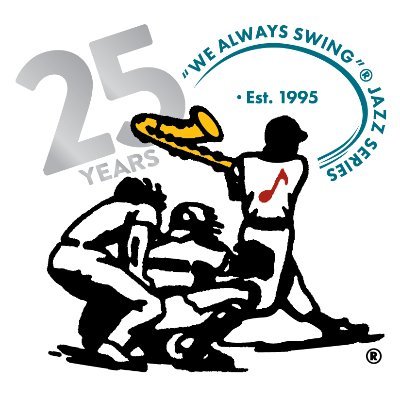 I was very fortunate that a friend of mine became a graphic artist early in the game. What's more, she was an early Photoshop user. I showed her the LP cover of The Mexican Bandit (Paul Gonsalves) Meets The Pittsburgh Pirate (Roy Eldridge) (Fantasy/OJC), which features Eldridge in a baseball pose swinging his trumpet and Gonsalves aiming his saxophone at him. In matter-of-fact fashion, my friend said, referring to the baseball pose on the checks, "I can replace the bat and put a trumpet in the batter's hands, and change the number on the back of the uniform to a note."
I was very fortunate that a friend of mine became a graphic artist early in the game. What's more, she was an early Photoshop user. I showed her the LP cover of The Mexican Bandit (Paul Gonsalves) Meets The Pittsburgh Pirate (Roy Eldridge) (Fantasy/OJC), which features Eldridge in a baseball pose swinging his trumpet and Gonsalves aiming his saxophone at him. In matter-of-fact fashion, my friend said, referring to the baseball pose on the checks, "I can replace the bat and put a trumpet in the batter's hands, and change the number on the back of the uniform to a note." I had no idea that was even possible. A few minutes later, the beginnings of the National Pastimes Productions logo magically appeared. After trying various tilts of the trumpet, I asked about replacing it with a tenor saxophone. After just a couple of angle adjustments, "The Swinging Saxophonist" hatched.
The logo—merging our two national pastimes—became a reality with my checks, initial brochures, business cards, stationary, et. al.; all showcased "The Swinging Saxophonist." Today, National Pastimes Productions—which still operates as a sole proprietorship—and the "We Always Swing" Jazz Series continue to do so. About eight years ago, the logo became a registered trademark as did "We Always Swing. I personally own the logo and license it for $0 to the Jazz Series, which owns the "We Always Swing" trademark.
AAJ: Is there a performance(s) that sticks out as a favorite or that is most memorable?
JP: There are plenty of them and for a variety of reasons. Hard to pick them, actually. Each season unfolds with untold surprises. We try to be as creative as possible, as often as we can. Here are a few events we have presented that are listed in no particular order. Each stands on its own. "A Night of Jazz A Baseball" (April 2001). The fundraiser, attended by 800+ people featured Bob Costas, Ken Burns and Gerald Early; former major league ballplayers Orlando Cepeda, Don Newcombe, Tommy Davis and Carmen Fanzone; a nine-piece ensemble with James Williams serving as musical director. Band: Von Freeman, Bobby Watson, Steve Wilson, Terell Stafford, Ray Drummond and Christian McBride (so they could play "Two Bass Hit") and Tony Reedus.
Thanks to an NEA Jazz Masters Live! Grant, we were able to commission NEA Jazz Master Bob Brookmeyer to write new music for the Vanguard Jazz Orchestra and have the world premiere here (February 2009). "Suite For Three" ultimately became part of GRAMMY-winning VJO release Over Time: The Music of Bob Brookmeyer (Planet Arts) Part I, "Suite For Three"—-World Premiere—Live from Missouri Theatre (Features Dick Oatts). A Q&A between Brookmeyer and NEA Jazz Master/Historian Dan Morgenstern was also part of the multi-day event.
Contemporary Piano Ensemble with: Harold Mabern, James Williams, Mulgrew Miller, Geoff Keezer and Donald Brown with Christian McBride and Tony Reedus (April 1995) Yamaha Artist Services provided four matching C7 pianos in 1993 for a 19-city tour in a 23—-day stretch; this was a follow-up performance. Columbia hosted on both occasions.
Captain Black Big Band: A Musical Tribute To Thomas Hart Benton (February 2016). Originally commissioned by the Metropolitan Museum of Art, the Jazz Series is the only other organization in the country to present the Orrin Evans, 10-piece ensemble's hour-long work.
Robin D.G. Kelley, Gerald Early and Kenny Barron Trio: "A Chunk Of Monk"—A three-day symposium centered on Thelonious Monk including films, panels and performance (October 2012).
New Year's Eve Broadcasts (two of them). First, Rene Marie: NPR's New Year's Eve "Toast of the Nation" national broadcast (December 31, 2005). Along with New Orleans, were the site of the Midwest part of the broadcast. Second, Bobby Watson & Horizon (December 31, 2009)
Since 1995 we have presented 60-plus NEA Jazz Masters. Among them: Chick Corea, Marian McPartland, Herbie Hancock, Toshiko Akiyoshi, Clark Terry, Ray Brown, Maria Schneider, Pat Metheny, Frank Wess, Milt Jackson, Barry Harris, Joe Henderson, Dave Brubeck, Dianne Reeves, JoAnne Brackeen, Regina Carter, Kenny Garrett.
The James Williams Education and Community Outreach Program honors the pianist who was so generous with his time to so many people, colleagues and associates. He performed Jazz Series concerts on a number of occasions. Von Freeman Memorial Lending Library is an in-house 9,000+ CD/LP/literature collection named—and formally dedicated by Chico Freeman in a public ceremony. It's open to the public daily. Anyone can come in and listen. People become members and are allowed to check out titles weekly. Even in the download era, the collection, which includes the entirety of jazz history, receives use. Last year we were able to index the collection online.
AAJ: You obviously have a great love of jazz. How did you discover it and have you ever been a musician yourself?
JP: I've always been around music. My parents had a pretty good LP collection, though not that much jazz beyond the obvious. As a child, I took "classical" piano; hated it. Switched to guitar as a young teenager; didn't practice; had stage fright, too. Gave it up. In high school I "lived" (pretty much) at the Fillmore East, going to concerts all the time.
It was actually my younger brother, six years my junior, who turned me on to jazz. He got into playing tenor saxophone barely when he hit double-digit age. The real start, though, was after college when, as a 23-year-old, I went to Europe in 1976. I landed at Montreux. I couldn't afford tickets to the festival but was offered entry each day if I helped clean up after the previous night's events. I went six or seven days straight. I saw a lot of people for the first time: Sun Ra, Cecil Taylor, Stan Getz with Brackeen and Billy Hart in the band, Herbie Hancock and who knows who else. I came away from Montreux totally hooked. I moved from the Fillmore to Bradley's, Village Vanguard, Fat Tuesday's, Boomer's, Studio Rivbea and other lofts, etc.
Today, when people ask me what I play, I say "The Telephone."
AAJ: Has your Master's in Journalism helped you in your work as a jazz promoter?
JP: Everyday. I'm either writing a grant, a press release, thank you letters to donors, website copy, brochure copy, you name it, including answering your astute questions. Our organization only has two full-time people and two part-timers. Not to boast, but I think we do a lot with quite a little. Outside of the Jazz Series I have contributed a twice monthly column to the Columbia (MO) Daily Tribune for 25 years; I've contributed 100-plus sets of liner notes; I've also written players' bios and other materials for them as part of National Pastimes Productions; I keep my hand-time permitting-in artist management and booking. No more cross-country van trips, though!
AAJ: Are you optimistic about the future of your Jazz Series?
JP: In a word, yes, but you have to be realistic. Columbia and the immediate surrounding area, though it's more than doubled since I arrived in 1978, is still a relatively small market. As much as I would like to think that the day we announce tickets go on sale that all the concerts sellout, that's simply not going to happen. Then, again, the first season-1995/1996-which consisted of six concerts: Ray Brown, Brackeen, Slide Hampton's Jazz Masters "Bird @ 75," Contemporary Piano Ensemble, Eric Reed with Kevin Mahogany and Poncho Sanchez-we sold 13 season tickets (78 total tickets). That year, with something like a $30,000 annual budget, we sold 1,200 tickets total, grossing something like $19,000. Not so good.
We now produce, counting concerts, educational/in-school and community activities, something like 50-plus events annually of which 12 to 14 are included as part of our concert subscription series. We now attract about 130 to 140 season ticket holders—people purchasing tickets to every concert. Our annual budget is approximately $350,000; ticket sales account for about one-third of that. The fact is in this market—at least as of now—hard ticket sales will never match the annual budget. That is the reality and one of the larger challenges of this project.
The first season, 65 individuals contributed a total of $3,500. The goal for the current fiscal year (July 1, 2022-June 30, 2023) is $120,000. Our highest total ever—$127,000—took place two years ago during the height of COVID-19. That cycle, more than 600 contributors living in 33 states, coast-to-coast, including Hawaii and Alaska contributed when, for six months, we didn't produce a single event. That tells me there are people—granted mostly local and in the immediate area—who really care about the "We Always Swing" Jazz Series and want to make sure it thrives beyond, as it should, my tenure.
In late June we announced the long-awaited launch of the "We Always Swing" Foundation, a wholly separate entity from our day-to-day operations, but one designed to bolster and eventually serve to increase the organization's overall stability. The Foundation begins with a quite modest sum, but one that exceeds the Jazz Series' inaugural annual budget some 28 years ago. You have to feel good about that. Ultimately, the goal is to have the fund increase to the point where it ensures the Jazz Series "lives" in perpetuity.
I'll have to make it a point to return, years from now, when that day arrives.
Tags
Chats with Cats
B.D. Lenz
United States
Missouri
Columbia
We Always Swing
We Always Swing Jazz Series
Jon Poses
PREVIOUS / NEXT
Support All About Jazz
 All About Jazz has been a pillar of jazz since 1995, championing it as an art form and, more importantly, supporting the musicians who make it. Our enduring commitment has made "AAJ" one of the most culturally important websites of its kind, read by hundreds of thousands of fans, musicians and industry figures every month.
All About Jazz has been a pillar of jazz since 1995, championing it as an art form and, more importantly, supporting the musicians who make it. Our enduring commitment has made "AAJ" one of the most culturally important websites of its kind, read by hundreds of thousands of fans, musicians and industry figures every month.

